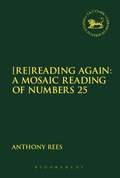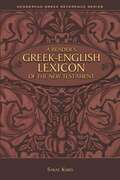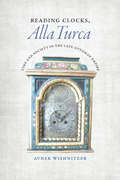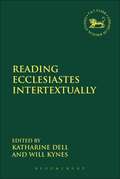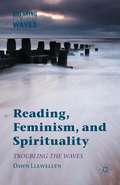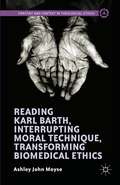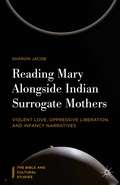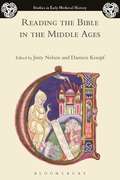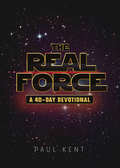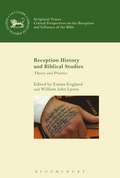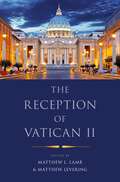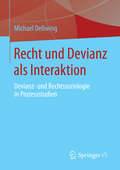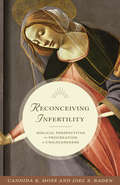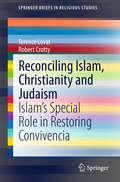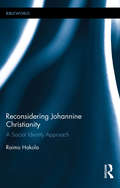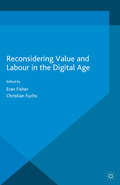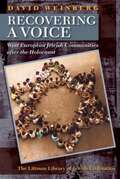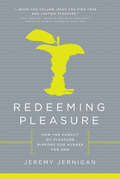- Table View
- List View
[Re]Reading Again: A Mosaic Reading of Numbers 25 (The Library of Hebrew Bible/Old Testament Studies #589)
by Anthony ReesGuided by the metaphor of the art form known as a mosaic, this book advocates a pluralistic approach to biblical studies. Rees argues that the text itself can be described as a 'mosaic', with each new reading adding to the mosaic.Interpretation is therefore both observation and invention, or contribution.When [re]reading the text, one cannot but be aware of what has been seen before, even if it at first may seem unfamiliar. He thus rejects the idea of a definitive reading. Examining Numbers 25, Rees argues that the various methods employed to interpret thistext (narrative, feminist, postcolonial as well as a more 'traditional' historical-critical reading) enable us to see different things as we read from different places. A further analysis of the book's interpretative history, including the rewritten histories of Josephus and Philo, allows us to discover that creativity has forever been a part of the reading process. Moving on to explore the contributions of more recent commentators, Rees concludes that an embrace of diversity, of collegiality, may well point to a new future in Biblical Studies.
A Reader's Greek-English Lexicon of the New Testament (Zondervan Greek Reference)
by Sakae KuboWhen you want to get straight to the heart of meaning in the Greek New Testament, A Reader’s Greek-English Lexicon to the New Testament is indispensable. By eliminating time-consuming lexical work, this book helps the pastor or student read the Greek New Testament easily and swiftly. Features: * All words that occur fewer than 50 times in the New Testament appear verse by verse * The translation is provided next to each word * A list at the beginning of each book shows words that occur more than five times in that book but less than 50 in the New Testament * In-text frequency numbers show how often a word is used both in a given book and in the entire New Testament * An appendix lists all words that occur more than 50 times * Definitions are based on the Bauer-Arndt-Gingrich Greek-English Lexicon (BAG) By making rapid reading of the Greek text possible, A Reader’s Greek-English Lexicon to the New Testament provides a powerful study tool for pastors, students, and all who have a high regard for the New Testament.
Reading Clocks, Alla Turca: Time and Society in the Late Ottoman Empire
by Avner WishnitzerUp until the end of the eighteenth century, the way Ottomans used their clocks conformed to the inner logic of their own temporal culture. However, this began to change rather dramatically during the nineteenth century, as the Ottoman Empire was increasingly assimilated into the European-dominated global economy and the project of modern state building began to gather momentum. In Reading Clocks, Alla Turca, Avner Wishnitzer unravels the complexity of Ottoman temporal culture and for the first time tells the story of its transformation. He explains that in their attempt to attain better surveillance capabilities and higher levels of regularity and efficiency, various organs of the reforming Ottoman state developed elaborate temporal constructs in which clocks played an increasingly important role. As the reform movement spread beyond the government apparatus, emerging groups of officers, bureaucrats, and urban professionals incorporated novel time-related ideas, values, and behaviors into their self-consciously “modern” outlook and lifestyle. Acculturated in the highly regimented environment of schools and barracks, they came to identify efficiency and temporal regularity with progress and the former temporal patterns with the old political order. Drawing on a wealth of archival and literary sources, Wishnitzer’s original and highly important work presents the shifting culture of time as an arena in which Ottoman social groups competed for legitimacy and a medium through which the very concept of modernity was defined. Reading Clocks, Alla Turca breaks new ground in the study of the Middle East and presents us with a new understanding of the relationship between time and modernity.
Reading Clocks, Alla Turca: Time and Society in the Late Ottoman Empire
by Avner WishnitzerUp until the end of the eighteenth century, the way Ottomans used their clocks conformed to the inner logic of their own temporal culture. However, this began to change rather dramatically during the nineteenth century, as the Ottoman Empire was increasingly assimilated into the European-dominated global economy and the project of modern state building began to gather momentum. In Reading Clocks, Alla Turca, Avner Wishnitzer unravels the complexity of Ottoman temporal culture and for the first time tells the story of its transformation. He explains that in their attempt to attain better surveillance capabilities and higher levels of regularity and efficiency, various organs of the reforming Ottoman state developed elaborate temporal constructs in which clocks played an increasingly important role. As the reform movement spread beyond the government apparatus, emerging groups of officers, bureaucrats, and urban professionals incorporated novel time-related ideas, values, and behaviors into their self-consciously “modern” outlook and lifestyle. Acculturated in the highly regimented environment of schools and barracks, they came to identify efficiency and temporal regularity with progress and the former temporal patterns with the old political order. Drawing on a wealth of archival and literary sources, Wishnitzer’s original and highly important work presents the shifting culture of time as an arena in which Ottoman social groups competed for legitimacy and a medium through which the very concept of modernity was defined. Reading Clocks, Alla Turca breaks new ground in the study of the Middle East and presents us with a new understanding of the relationship between time and modernity.
Reading Clocks, Alla Turca: Time and Society in the Late Ottoman Empire
by Avner WishnitzerUp until the end of the eighteenth century, the way Ottomans used their clocks conformed to the inner logic of their own temporal culture. However, this began to change rather dramatically during the nineteenth century, as the Ottoman Empire was increasingly assimilated into the European-dominated global economy and the project of modern state building began to gather momentum. In Reading Clocks, Alla Turca, Avner Wishnitzer unravels the complexity of Ottoman temporal culture and for the first time tells the story of its transformation. He explains that in their attempt to attain better surveillance capabilities and higher levels of regularity and efficiency, various organs of the reforming Ottoman state developed elaborate temporal constructs in which clocks played an increasingly important role. As the reform movement spread beyond the government apparatus, emerging groups of officers, bureaucrats, and urban professionals incorporated novel time-related ideas, values, and behaviors into their self-consciously “modern” outlook and lifestyle. Acculturated in the highly regimented environment of schools and barracks, they came to identify efficiency and temporal regularity with progress and the former temporal patterns with the old political order. Drawing on a wealth of archival and literary sources, Wishnitzer’s original and highly important work presents the shifting culture of time as an arena in which Ottoman social groups competed for legitimacy and a medium through which the very concept of modernity was defined. Reading Clocks, Alla Turca breaks new ground in the study of the Middle East and presents us with a new understanding of the relationship between time and modernity.
Reading Clocks, Alla Turca: Time and Society in the Late Ottoman Empire
by Avner WishnitzerUp until the end of the eighteenth century, the way Ottomans used their clocks conformed to the inner logic of their own temporal culture. However, this began to change rather dramatically during the nineteenth century, as the Ottoman Empire was increasingly assimilated into the European-dominated global economy and the project of modern state building began to gather momentum. In Reading Clocks, Alla Turca, Avner Wishnitzer unravels the complexity of Ottoman temporal culture and for the first time tells the story of its transformation. He explains that in their attempt to attain better surveillance capabilities and higher levels of regularity and efficiency, various organs of the reforming Ottoman state developed elaborate temporal constructs in which clocks played an increasingly important role. As the reform movement spread beyond the government apparatus, emerging groups of officers, bureaucrats, and urban professionals incorporated novel time-related ideas, values, and behaviors into their self-consciously “modern” outlook and lifestyle. Acculturated in the highly regimented environment of schools and barracks, they came to identify efficiency and temporal regularity with progress and the former temporal patterns with the old political order. Drawing on a wealth of archival and literary sources, Wishnitzer’s original and highly important work presents the shifting culture of time as an arena in which Ottoman social groups competed for legitimacy and a medium through which the very concept of modernity was defined. Reading Clocks, Alla Turca breaks new ground in the study of the Middle East and presents us with a new understanding of the relationship between time and modernity.
Reading Ecclesiastes Intertextually (The Library of Hebrew Bible/Old Testament Studies #587)
by Katharine J. Dell Will KynesThis volume continues the study of intertextuality in the 'Wisdom Literature' initiated in Reading Job Intertextually (Dell and Kynes, T&T Clark, 2012). Like that book, Reading Ecclesiastes Intertextually provides the first comprehensive treatment of intertextuality in this wisdom text. Articles address intertextual resonances between Ecclesiastes and texts across the Hebrew canon, along with texts throughout history, from Greek classical literature to the New Testament, Jewish and Christian interpretation, and existential and Modern philosophy.As a multi-authored volume that gathers together scholars with expertise on this diverse array of texts, this collection provides exegetical insight that exceeds any similar attempt by a single author. The contributors have been encouraged to pursue the intertextual approach that best suits their topic, thereby offering readers a valuable collection of intertextual case studies addressing a single text.
Reading, Feminism, and Spirituality: Troubling the Waves (Breaking Feminist Waves)
by Dawn LlewellynThrough original interviews and research, Llewellyn uses spirituality to uncover new commonalities between the second and third feminist waves, and sacred and secular experiences. Her lively approach highlights the importance of reading cultures in feminist studies, connecting women's voices across generations, literary practices, and religions.
Reading Karl Barth, Interrupting Moral Technique, Transforming Biomedical Ethics (Content and Context in Theological Ethics)
by Ashley John MoyseThis volume proposes a move away from the universalized and general modern ethical method, as it is currently practiced in biomedical ethics, while aiming toward a decision making process rooted in an ontology of relationality. Moyse uses the theological ethics of Karl Barth, in conversation with a range of thinkers, to achieve this turn.
Reading Mary Alongside Indian Surrogate Mothers: Violent Love, Oppressive Liberation, and Infancy Narratives (The Bible and Cultural Studies)
by Sharon JacobThis book attempts to read the character of Mary in the infancy narratives of Luke and Matthew alongside the lives of experiences of the Indian surrogate mother living a postcolonial India. Reading Mary through these lenses helps us see this mother and her actions in a more ambivalent light, as a mother whose love is both violent and altruistic.
Reading the Bible in the Middle Ages (Studies in Early Medieval History)
by Jinty Nelson Damien KempfFor earlier medieval Christians, the Bible was the book of guidance above all others, and the route to religious knowledge, used for all kinds of practical purposes, from divination to models of government in kingdom or household. This book's focus is on how medieval people accessed Scripture by reading, but also by hearing and memorizing sound-bites from the liturgy, chants and hymns, or sermons explicating Scripture in various vernaculars. Time, place and social class determined access to these varied forms of Scripture. Throughout the earlier medieval period, the Psalms attracted most readers and searchers for meanings.This book's contributors probe readers' motivations, intellectual resources and religious concerns. They ask for whom the readers wrote, where they expected their readers to be located and in what institutional, social and political environments they belonged; why writers chose to write about, or draw on, certain parts of the Bible rather than others, and what real-life contexts or conjunctures inspired them; why the Old Testament so often loomed so large, and how its law-books, its histories, its prophetic books and its poetry were made intelligible to readers, hearers and memorizers. This book's contributors, in raising so many questions, do justice to both uniqueness and diversity.
Reading the Bible in the Middle Ages (Studies in Early Medieval History)
by Jinty Nelson Damien KempfFor earlier medieval Christians, the Bible was the book of guidance above all others, and the route to religious knowledge, used for all kinds of practical purposes, from divination to models of government in kingdom or household. This book's focus is on how medieval people accessed Scripture by reading, but also by hearing and memorizing sound-bites from the liturgy, chants and hymns, or sermons explicating Scripture in various vernaculars. Time, place and social class determined access to these varied forms of Scripture. Throughout the earlier medieval period, the Psalms attracted most readers and searchers for meanings.This book's contributors probe readers' motivations, intellectual resources and religious concerns. They ask for whom the readers wrote, where they expected their readers to be located and in what institutional, social and political environments they belonged; why writers chose to write about, or draw on, certain parts of the Bible rather than others, and what real-life contexts or conjunctures inspired them; why the Old Testament so often loomed so large, and how its law-books, its histories, its prophetic books and its poetry were made intelligible to readers, hearers and memorizers. This book's contributors, in raising so many questions, do justice to both uniqueness and diversity.
The Real Force: A Forty Day Devotional
by Paul KentThe Force Awakens, the Fall 2015 installment in the Star Wars franchise, promises to excite the longtime enthusiast and enthrall a new generation of admirers. The Real Force comprises forty biblically sound devotions revealing the Christian themes found in the epic Star Wars saga.
Reception History and Biblical Studies: Theory and Practice (The Library of Hebrew Bible/Old Testament Studies)
by Emma England William John LyonsHow do we begin to carry out such a vast task-the examination of three millennia of diverse uses and influences of the biblical texts? Where can the interested scholar find information on methods and techniques applicable to the many and varied ways in which these have happened?Through a series of examples of reception history practitioners at work and of their reflections this volume sets the agenda for biblical reception, as it begins to chart the near-infinite series of complex interpretive 'events' that have been generated by the journey of the biblical texts down through the centuries. The chapters consider aspects as diverse as political and economic factors, cultural location, the discipline of Biblical Studies, and the impact of scholarly preconceptions, upon reception history. Topics covered include biblical figures and concepts, contemporary music, paintings, children's Bibles, and interpreters as diverse as Calvin, Lenin, and Nick Cave.
Reception History and Biblical Studies: Theory And Practice (The Library of Hebrew Bible/Old Testament Studies #611)
by William John Lyons Dr Emma EnglandHow do we begin to carry out such a vast task-the examination of three millennia of diverse uses and influences of the biblical texts? Where can the interested scholar find information on methods and techniques applicable to the many and varied ways in which these have happened?Through a series of examples of reception history practitioners at work and of their reflections this volume sets the agenda for biblical reception, as it begins to chart the near-infinite series of complex interpretive 'events' that have been generated by the journey of the biblical texts down through the centuries. The chapters consider aspects as diverse as political and economic factors, cultural location, the discipline of Biblical Studies, and the impact of scholarly preconceptions, upon reception history. Topics covered include biblical figures and concepts, contemporary music, paintings, children's Bibles, and interpreters as diverse as Calvin, Lenin, and Nick Cave.
RECEPTION OF VATICAN 2 C
by Matthew L. Lamb and Matthew LeveringFrom 1962 to 1965, in perhaps the most important religious event of the twentieth century, the Second Vatican Council met to plot a course for the future of the Roman Catholic Church. After thousands of speeches, resolutions, and votes, the Council issued sixteen official documents on topics ranging from divine revelation to relations with non-Christians. But the meaning of the Second Vatican Council has been fiercely contested since before it was even over, and the years since its completion have seen a battle for the soul of the Church waged through the interpretation of Council documents. The Reception of Vatican II looks at the sixteen conciliar documents through the lens of those battles. Paying close attention to reforms and new developments, the essays in this volume show how the Council has been received and interpreted over the course of the more than fifty years since it concluded. The contributors to this volume represent various schools of thought but are united by a commitment to restoring the view that Vatican II should be interpreted and implemented in line with Church Tradition. The central problem facing Catholic theology today, these essays argue, is a misreading of the Council that posits a sharp break with previous Church teaching. In order to combat this reductive way of interpreting the Council, these essays provide a thorough, instructive overview of the debates it inspired.
Recht und Devianz als Interaktion: Devianz- und Rechtssoziologie in Prozessstudien
by Michael DellwingDie vorliegenden Texte nehmen Bezug auf die grundlegenden Arbeiten Howard S. Beckers, Herbert Blumers und Stanley Fishs, deren Ansätze in erster Linie die lokale Kategorisierung im interaktiven Raum zwischen in konkreten Situationen handelnden Menschen betonen.Sowohl die interaktionistische Devianzsoziologie als auch der Rechtspragmatismus haben in diesem Sinne lange gegen die Position opponiert, Abweichung bzw. Kriminalität wären bereits im Vergleich von Verhalten mit sozialen bzw. rechtlichen Normen abstrakt bestimmbar. Das hat sie dazu bewogen, nicht Kategorien und ihre Erfüllung zu untersuchen, sondern die Prozesse, in denen solche Bestimmungen lokal geleistet werden: An die Stelle einer Erforschung rechtlicher oder sozialer Normen oder Ordnung haben sie eine Erforschung menschlicher Definitionsaktivität in Interaktionssituationen gesetzt. Sowohl devianzinteraktionistische als auch rechtspragmatistische Ansätze nehmen diese Aktivität und ihre Lokalität ernst: Lebensweltlich ausgehandelte, kontextuale und veränderliche Kategorisierungen, nicht irgendwelche wissenschaftlich-abstrakten Kategorien, sind die einzigen praktisch realen Ordnungen, die wir vorweisen können.
Reconceiving Infertility: Biblical Perspectives on Procreation and Childlessness
by Candida R. Moss Joel S. BadenIn the Book of Genesis, the first words God speaks to humanity are "Be fruitful and multiply." From ancient times to today, these words have been understood as a divine command to procreate. Fertility is viewed as a sign of blessedness and moral uprightness, while infertility is associated with sin and moral failing. Reconceiving Infertility explores traditional interpretations such as these, providing a more complete picture of how procreation and childlessness are depicted in the Bible.Closely examining texts and themes from both the Hebrew Bible and the New Testament, Candida Moss and Joel Baden offer vital new perspectives on infertility and the social experiences of the infertile in the biblical tradition. They begin with perhaps the most famous stories of infertility in the Bible—those of the matriarchs Sarah, Rebekah, and Rachel—and show how the divine injunction in Genesis is both a blessing and a curse. Moss and Baden go on to discuss the metaphorical treatments of Israel as a "barren mother," the conception of Jesus, Paul's writings on family and reproduction, and more. They reveal how biblical views on procreation and infertility, and the ancient contexts from which they emerged, were more diverse than we think.Reconceiving Infertility demonstrates that the Bible speaks in many voices about infertility, and lays a biblical foundation for a more supportive religious environment for those suffering from infertility today.
Reconceiving Infertility: Biblical Perspectives on Procreation and Childlessness
by Candida R. Moss Joel S. BadenIn the Book of Genesis, the first words God speaks to humanity are "Be fruitful and multiply." From ancient times to today, these words have been understood as a divine command to procreate. Fertility is viewed as a sign of blessedness and moral uprightness, while infertility is associated with sin and moral failing. Reconceiving Infertility explores traditional interpretations such as these, providing a more complete picture of how procreation and childlessness are depicted in the Bible.Closely examining texts and themes from both the Hebrew Bible and the New Testament, Candida Moss and Joel Baden offer vital new perspectives on infertility and the social experiences of the infertile in the biblical tradition. They begin with perhaps the most famous stories of infertility in the Bible—those of the matriarchs Sarah, Rebekah, and Rachel—and show how the divine injunction in Genesis is both a blessing and a curse. Moss and Baden go on to discuss the metaphorical treatments of Israel as a "barren mother," the conception of Jesus, Paul's writings on family and reproduction, and more. They reveal how biblical views on procreation and infertility, and the ancient contexts from which they emerged, were more diverse than we think.Reconceiving Infertility demonstrates that the Bible speaks in many voices about infertility, and lays a biblical foundation for a more supportive religious environment for those suffering from infertility today.
Reconciling Islam, Christianity and Judaism: Islam’s Special Role in Restoring Convivencia (SpringerBriefs in Religious Studies)
by Terence Lovat Robert CrottyAt the present time, when so-called Islamic radicalism, terrorism and Jihadism occupy major media space, with Islam often depicted as the main culprit, the book attempts a tour de force. It proposes that Islam is as much victim as culprit in the history that has led to the current hostility. This is because the common claims of both mainstream and radical Islam that Islam represents the high point of the Abrahamic tradition, and therefore a purification of Judaism and Christianity, have been largely ignored, misunderstood or blatantly rejected by these faiths and therefore by ‘the West’ in general. This rejection has effectively rendered Islam as the poor cousin, if not the illegitimate sibling, of the tradition. In turn, this has created long-term resentment and hostility within Islam as well as robbed the ‘Judaeo-Christian West’ of a rich, inter-faith understanding of the wider Abrahamic tradition. The book explores these claims through textual, historical and theological analyses, proposing that many of them stand up better to critical scrutiny than has been commonly acknowledged. It further proposes that seeing Islam in this way has potential to re-awaken its self-understanding as a leader of accord among the Abrahamic faiths, of the kind that characterized the era of Convivencia when, in medieval Spain, Islam constructed and contributed to advanced civilizations characterized by relatively harmonious co-existence between Muslims, Christians and Jews. The book focuses on the role that a more respected and self-confident Islam could play in forging enhanced inter-faith relations in a world that desperately needs them as it struggles to understand and deal with modern and particularly vicious forms of radical Islamism.
Reconsidering Johannine Christianity: A Social Identity Approach (BibleWorld)
by Raimo HakolaReconsidering Johannine Christianity presents a full-scale application of social identity approach to the Johannine writings. This book reconsiders a widely held scholarly assumption that the writings commonly taken to represent Johannine Christianity – the Gospel of John and the First, Second and Third Epistles of John – reflect the situation of an introverted early Christian group. It claims that dualistic polarities appearing in these texts should be taken as attempts to construct a secure social identity, not as evidence of social isolation. While some scholars (most notably, Richard Bauckham) have argued that the New Testament gospels were not addressed to specific early Christian communities but to all Christians, this book proposes that we should take different branches of early Christianity, not as localized and closed groups, but as imagined communities that envision distinct early Christian identities. It also reassesses the scholarly consensus according to which the Johannine Epistles presuppose and build upon the finished version of the Fourth Gospel and argues that the Johannine tradition, already in its initial stages, was diverse.
Reconsidering Johannine Christianity: A Social Identity Approach (BibleWorld)
by Raimo HakolaReconsidering Johannine Christianity presents a full-scale application of social identity approach to the Johannine writings. This book reconsiders a widely held scholarly assumption that the writings commonly taken to represent Johannine Christianity – the Gospel of John and the First, Second and Third Epistles of John – reflect the situation of an introverted early Christian group. It claims that dualistic polarities appearing in these texts should be taken as attempts to construct a secure social identity, not as evidence of social isolation. While some scholars (most notably, Richard Bauckham) have argued that the New Testament gospels were not addressed to specific early Christian communities but to all Christians, this book proposes that we should take different branches of early Christianity, not as localized and closed groups, but as imagined communities that envision distinct early Christian identities. It also reassesses the scholarly consensus according to which the Johannine Epistles presuppose and build upon the finished version of the Fourth Gospel and argues that the Johannine tradition, already in its initial stages, was diverse.
Reconsidering Value and Labour in the Digital Age (Dynamics of Virtual Work)
by Christian Fuchs Eran FisherThis volume explores current interventions into the digital labour theory of value, proposing theoretical and empirical work that contributes to our understanding of Marx's labour theory of value, proposes how labour and value are transformed under conditions of virtuality, and employ the theory in order to shed light on specific practices.
Recovering a Voice: West European Jewish Communities after the Holocaust (The Littman Library of Jewish Civilization)
by David WeinbergDavid Weinberg’s multi-national study focuses on the efforts by the Jews of France, Belgium, and the Netherlands to reconstruct their lives after the Second World War. These efforts have largely been ignored, perhaps because the emphasis on assisting survivors in displaced persons camps in occupied Germany, Austria, and Italy and in developing Israel as the centre of the Jewish world after the Holocaust diverted attention from the struggle by Jews in western Europe to recover their voice and sense of purpose. Weinberg attempts to set the record straight, presenting the challenges that were faced both in the national context and in the world Jewish arena and examining how they were dealt with. Weinberg begins his study by reviewing the action taken to revive Jewish communities in the three countries materially and institutionally, remodelling them as efficient, self-sustaining, and assertive bodies that could meet new challenges. With the creation of the State of Israel, Jews who stayed in western Europe had to defend their decision to do so while nevertheless showing public support for the new nation. There was also a felt need to respond quickly and effectively to any sign of antisemitism. In addition, tensions arose between Jews and non-Jews concerning wartime collaboration in deportations, and the need to memorialize Jewish victims of Nazism. The Cold War offered challenges of its own: the perceived need to exclude communist elements from communal affairs was countered by a resistance to pressures from American Jewish leaders to sever links with Jews in eastern Europe. Yet beneath the show of assertiveness Jewish life was fragile, not only because of the physical depletion of the population and of its leadership but because the Holocaust had shaken religious beliefs and affiliations and had raised questions about the value of preserving ethnic and religious identity. At the same time, new forms of Jewish consciousness had evolved, meaning that Jewish leaders had to provide for diverse educational, religious, and cultural needs. This book's comprehensive approach offers a broad and valuable addition to existing studies on the regeneration of Jewish life in individual European countries. Underscoring the similar political, cultural, social, and economic issues facing Jewish survivors in France, Belgium, and the Netherlands after the Holocaust, David Weinberg demonstrates how, with the aid of international Jewish organizations, they used unprecedented means to meet unprecedented challenges. It is a story worth telling that adds much to our understanding of postwar European Jewish life.
Redeeming Pleasure: How the Pursuit of Pleasure Mirrors Our Hunger for God
by Jeremy JerniganJeremy Jernigan, pastor of the twelve-thousand member Central Christian Church in Phoenix, Arizona, shows readers how to redeem pleasure from a culture that abuses it in ways God never intended.
